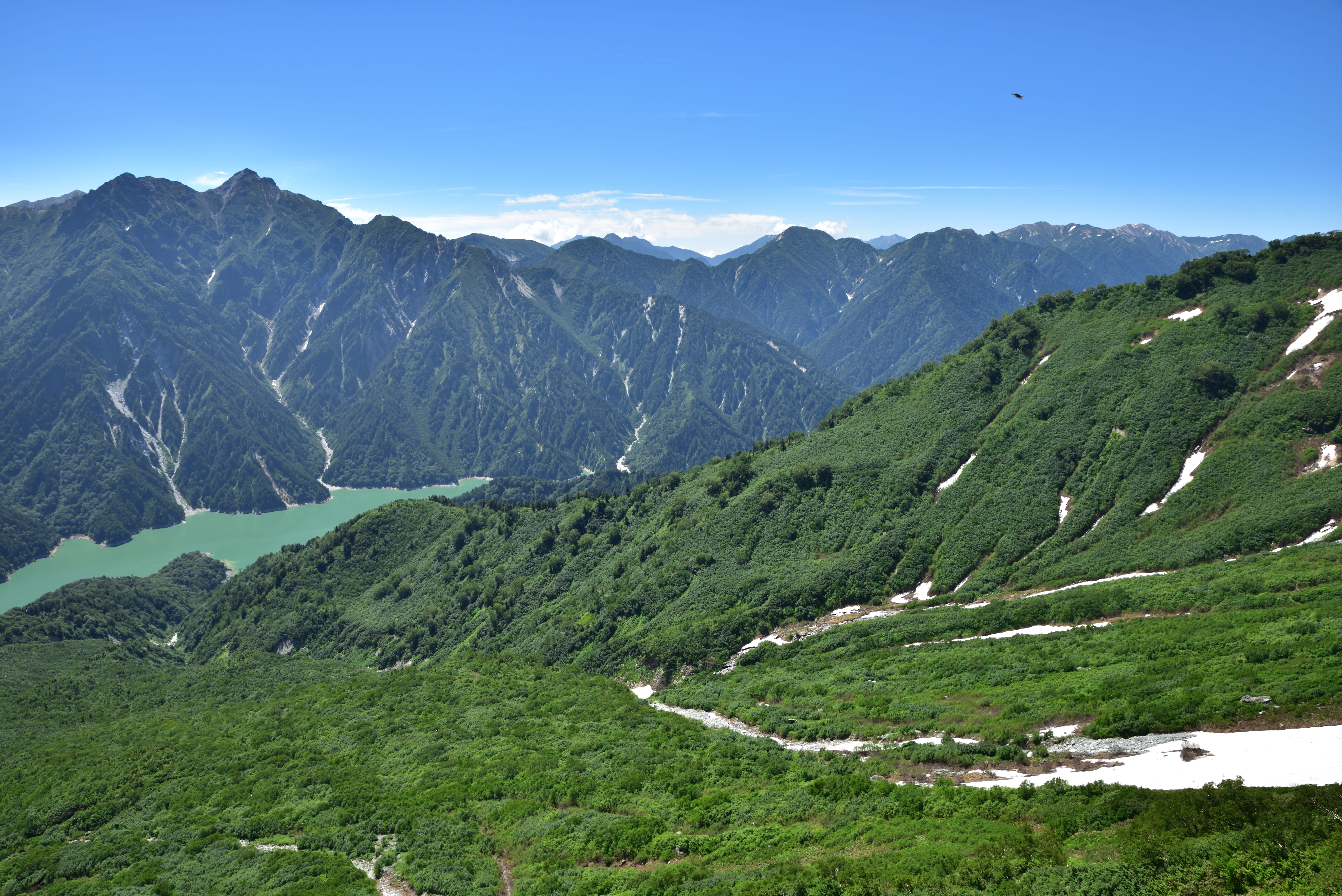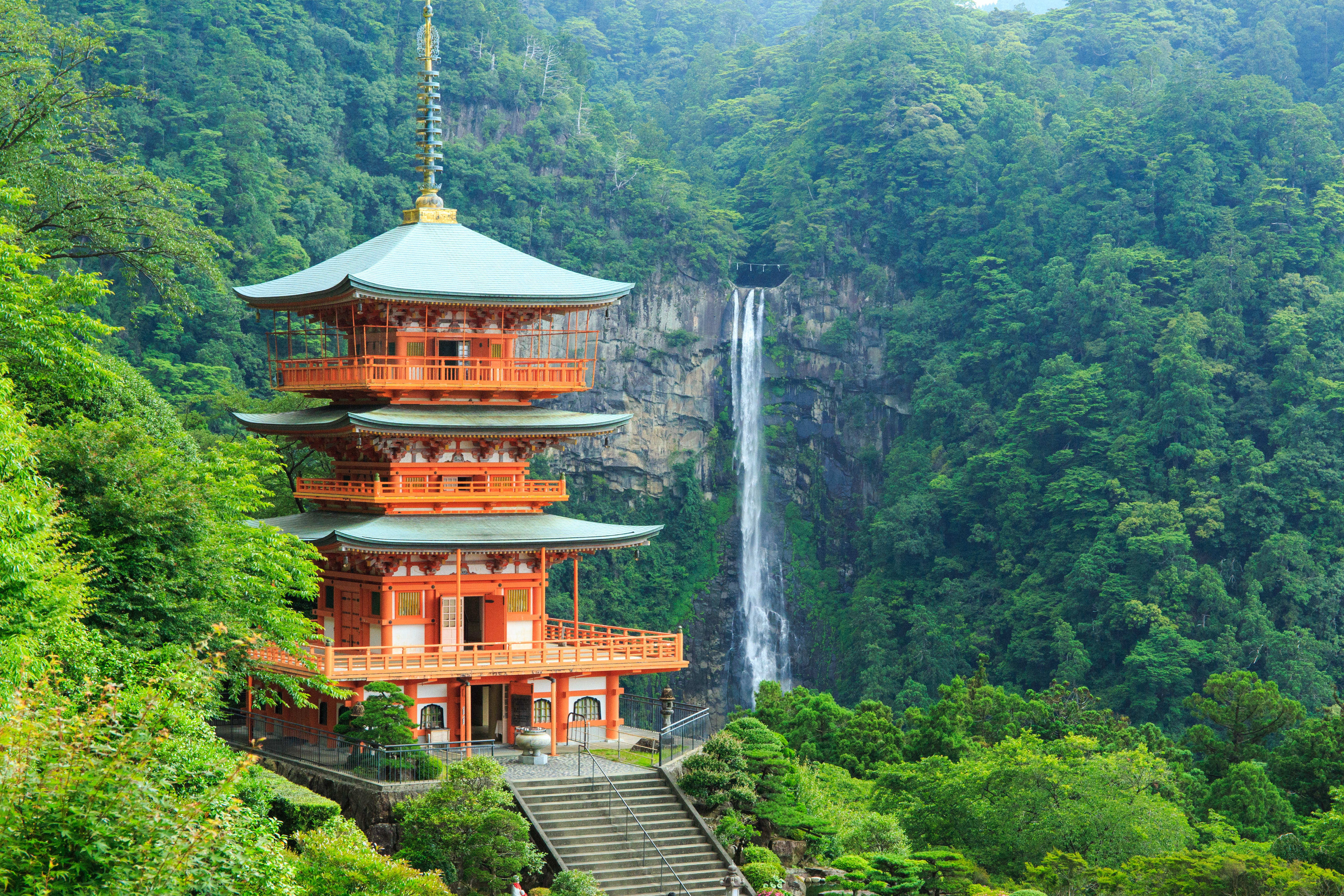
Mount Fuji seen across Lake Kawaguchiko in Fuji-Hakone-Izu National Park
Japan’s three sacred mountains
Since ancient times, mountains have been revered as sacred places in Japan. Sangaku shinko, or “mountain creed,” is a system of beliefs and rituals centered around mountain worship and reverence for one’s ancestors. These beliefs eventually fused with Buddhism and elements of Shintoism to create a faith called Shugendo, a combination of religious practices that focuses on reverence for nature and asceticism, which reached a high point during the Heian period (794-1185). In Shugendo, a number of mountains in Japan are sacred, but Mount Fuji, Mount Tateyama and Mount Hakusan are considered the country's three major holy peaks.
Mount Fuji, part of Fuji-Hakone-Izu National Park, is an iconic symbol of Japan and the country’s tallest peak, standing at a height of 3,776 meters. The mountain has been a place of pilgrimage for centuries, and hikes to the summit are still extremely popular. Today, paved roads lead partway up the mountain to the Fifth Stations of the four main hiking trails. In ancient times, however, pilgrims started their climbs from much further away. During the Edo period (1603–1867), pilgrims would embark on a long journey on foot from Edo, modern-day Tokyo, to the top of Fuji.

Along the ancient Ochudo Trail in Fuji-Hakone-Izu National Park
The Ochudo Trail, a path that encircles Mount Fuji around halfway up the mountain, was considered one of the most sacred routes on the mountain in the past—only those who had reached the peak of Fuji three times were allowed to walk it. Nowadays, part of the trail is used recreationally and is open year-round. Walking from the trailhead at the Fuji Subaru Line 5th Station through the Oniwa area to the Okuniwa area (3.7 km) is a popular way to experience this route. Hikers can see views of the Fuji Five Lakes, the Southern Japanese Alps, and Mount Yatsugatake along the way.
Mount Tateyama in Chubusangaku National Park became a very popular pilgrimage destination and training ground for Buddhist monks from the 17th century through the 19th century. People who climbed Mount Tateyama hope that their souls would go to heaven after their death. Oyama Shrine, built on Oyama peak on Mount Tateyama, offers a purification ceremony, and on a clear day you can see as far as Mount Fuji from here. The views of Jigokudani (Hell's Valley) from the summit, with its volcanic gasses and steam rising up, resembles hell.
Murodo, where Jigokudani is located, is easily accessible by the Tateyama Kurobe Alpine Route and is a popular mountain climbing base and tourist destination.
Mount Hakusan, located in Hakusan National Park, is the third of Japan’s “Three Sacred Mountains.” According to legend, the first person to successfully climb the peak was the Buddhist priest Taicho (682–767) who made the ascent in 717. Taicho was also an influential Shugendo practitioner. The people living in the areas surrounding the mountain, including Ishikawa, Gifu, Fukui, and Toyama prefectures, have long revered the mountain for its life-giving spring water that flows down its slopes, providing water for cultivating crops. Shirayama Himejinja Okumiya Shrine, located at the peak of Gozengamine, is dedicated to Hakusan and has around 2,700 branch shrines throughout Japan.
The most popular and accessible routes to the summit of Mount Hakusan are Sabo Shindo Trail, Kanko Shindo Trail and Hirase Trail. The Hakusan Murodo Visitors Center & Lodge, below the summit, serves as a climbing base and has lodging. At the peak, climbers can admire views of acidic blue-green ponds, the Japanese Alps and the Sea of Japan.

Views along the Tateyama Kurobe Alpine Route in Chubusangaku National Park
Dewa Sanzan: a journey of rebirth
Dewa Sanzan, literally the “Three Mountains of Dewa,” is a mountainous area in central Yamagata Prefecture within Bandai-Asahi National Park. It has a nearly 1,400-year-old history as a place of mountain worship and asceticism, and was further developed as a spiritual center during the Edo period (1603-1867), when a stone path lined with cedar trees was constructed leading up to the top of Mount Haguro. The pilgrimage route traverses three spiritual areas starting from Mount Haguro (representing the present), Mount Gassan (representing the past), and Mount Yudono (representing rebirth and the future). Walking the entire route is symbolic of a spiritual rebirth. Yamabushi, Japanese mountain ascetics and practitioners of the Shugendo faith, have trained in these mountains for centuries.
Today, visitors can experience yamabushi training practices through special guided programs, partake in prayer services at the shrines and temples around the mountains, and stay at a shukubo (pilgrims’ lodge) where shojin ryori, vegetarian ascetic cuisine, is served at mealtimes. Spiritual seekers can immerse themselves in Dewa Sanzan’s nature and cultural heritage by hiking the entire route from Mount Haguro over Mount Gassan and down to Mount Yudono, or experience the area through walking tours, such as one along the ancient Rokujuri-goe Kaido Road.

The path to Mount Haguro in Bandai-Asahi National Park
Seeking revitalization along the Kumano Kodo
The network of pilgrimage routes that weaves through the forests and mountains of the Kii Peninsula in Wakayama Prefecture are known as the Kumano Kodo. These routes were established nearly 1,200 years ago, becoming popular during the Heian period (794–1185), when the Imperial Court and nobles made annual pilgrimages from the ancient capital of Kyoto in search of “heaven on earth.” The area is considered the “birthplace of Shugendo,” where religious sites were established that fused elements of Buddhism, Taoism, mountain asceticism and nature worship. The pilgrimage routes, shrines and temples here are designated UNESCO World Heritage sites as the “Sacred Sites and Pilgrimage Routes in the Kii Mountain Range.”
The Nakahechi Route traverses part of Yoshino-Kumano National Park and includes the Three Grand Shrines of Kumano—Kumano-Nachi Taisha, Kumano-Hayatama Taisha, and Kumano-Hongu Taisha—as well as Nachisan Segantoji Temple and Nachi Falls. The Daimonzaka Slope, a stone staircase that leads to Seigantoji and Nachi Falls, is particularly atmospheric, surrounded by lush vegetation and towering cedars.
Visitors can experience the Kumano Kodo on multi-day treks, or enjoy sections of the pilgrimage on their own or with a guide. Learn about the history of the area, legendary figures and spiritual beliefs on a half-day tour with a storyteller from Daimonzaka to Nachi Falls, or walk along stone paths through beautiful forests on an eco-tour of the Kumano Kodo Iseji-Magose Pass, a historical route connecting Ise with Kumano. The Kumano area of the park is not only a place to learn about Japan’s spiritual heritage but also ideal for the therapeutic experience of forest bathing.

Nachisan Seigantoji Temple and Nachi Falls along the Kumano Kodo in Yoshino-Kumano National Park
A contemplative journey on the Shikoku Henro (88 Temple Pilgrimage)
This 1,400-kilometer-long circular route traverses lush mountains, valleys and forests on Shikoku, the smallest of Japan’s main islands, encompassing 88 temples dotted around the island. Traditionally, pilgrims travel alone on this journey, said to be accompanied in spirit by the priest Kobo Daishi (774–835), founder of the Shingon sect of Buddhism. He is believed to have trained in this area during the 9th century. Some pilgrims come for religious reasons, to pray for healing, safety, and in memory of loved ones who have passed away. For others, it is an opportunity to escape the stresses of everyday life, immerse themselves in Shikoku’s beautiful nature, and for physical fitness.
Walking the entire route would take around 40 days or longer, and is a challenging undertaking. For a sampling of this pilgrimage, visitors can experience a section of the route on an 8-hour walking tour which visits three temples on the Goshikidai Plateau in Setonaikai National Park. The 88-temple pilgrimage trail follows much of the coastline in southern Shikoku, passing through Ashizuri-Uwakai National Park. Visitors to the area can experience walking along rock terraces and precipitous cliffs, and immerse themselves in local culture where pilgrimage traditions live on. Many locals here offer osettai gifts—usually food and drink—to pilgrims. Kongofukuji Temple (temple 38), located at the southernmost tip of Shikoku on a hillside overlooking Cape Ashizuri, is a beautiful spot to visit.

Views from Goshikidai Plateau in Setonaikai National Park
All mountains are sacred in Japan
Even if you don’t visit the renowned mountains and pilgrimage routes listed here, you’ll be able to experience the sacredness of nature wherever you are in the parks. When you are out on mountain trails, look around for wooden or stone gates at trailheads, small shrines and temples on mountain peaks, or shimenawa—straw ropes with strands of lightning-bolt-shaped white paper tied around large rocks and trees. And while you're walking, contemplate the idea that traditionally, mountains in Japan are not meant to be conquered, but places to honor our forebears and offer gratitude for nature's blessings.

Togakushi-jinja Okusha Shrine in Myoko-Togakushi renzan National Park

























